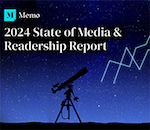Approximately one in five U.S. adults — or about 45 million Americans — said they no longer read the news at all anymore, whether it’s articles found online or in print, according to a recent study on the perceived credibility of the press released by San Francisco-based tech PR firm Bospar.
Aside from the alarming notion that nearly 20 percent of American adults admitted to no longer catching up on current events, Bospar’s Press Credibility Study also found that the older someone is, the less likely they are to read the news. Nearly a third — 28 percent — of Americans ages 65 or older said they never read the news, compared to about 20 percent of Baby Boomers (Americans between the ages of 55-64) and about 17 percent of Generation X members who admitted the same.
On the other hand, only 13 percent of Millennials (those between the ages of 21 and 34) said they avoid reading the news, the smallest percentage of any age group polled.
Men were slightly more likely to avoid reading the news than women, according to the study. And those who admitted not reading the news were statistically slightly more likely to reside in the Western U.S. or Midwest.
Of those who still read the headlines, 56 percent said their trust in an online or print news article is earned when the reporting relies on research derived from an unbiased source, such as a research firm or university. A journalist’s perceived lack of bias came in second place, at 47 percent. The use of infographics came in third (15 percent).
Millennials were far more inclined to value unbiased research and reporting (65 percent and 50 percent, respectively) than any other age group. Americans ages 65 and over were least likely to be persuaded by these factors than any age group polled.
Nearly a quarter of this Millennials (23 percent) also said they’re inspired to read an article when it contains infographics or employs a catchy headline (19 percent).
Bospar’s Press Credibility Study was conducted in early August by market research company Radius Global Market Research and polled 2, 220 U.S. residents online.


 Trump Media & Technology Group today reported a $58.2M net loss on $4.1M in 2023 revenues, a disclosure that drove its stock price down 22.6 percent to $47.96.
Trump Media & Technology Group today reported a $58.2M net loss on $4.1M in 2023 revenues, a disclosure that drove its stock price down 22.6 percent to $47.96. Barry Pollack, an attorney at Wall Street’s Harris St. Laurent & Wechsler, has registered Julian Assange as a client with the Justice Dept. “out of an abundance of caution.”
Barry Pollack, an attorney at Wall Street’s Harris St. Laurent & Wechsler, has registered Julian Assange as a client with the Justice Dept. “out of an abundance of caution.” Paramount Global to slash 800 jobs in what chief executive Bob Bakish calls part of an effort to “return the company to earnings growth"... Rolling Stone editor-in-chief Noah Shachtman is exiting at the end of the month due to disagreements with chief executive Gus Wenner over the direction the magazine is taking... The New York Times broke the $1 billion barrier in annual revenue from digital subscriptions in 2023... Press Forward is investing more than $500 million to strengthen local newsrooms.
Paramount Global to slash 800 jobs in what chief executive Bob Bakish calls part of an effort to “return the company to earnings growth"... Rolling Stone editor-in-chief Noah Shachtman is exiting at the end of the month due to disagreements with chief executive Gus Wenner over the direction the magazine is taking... The New York Times broke the $1 billion barrier in annual revenue from digital subscriptions in 2023... Press Forward is investing more than $500 million to strengthen local newsrooms. The majority of news articles are read within the first three days of publication, according to a recent report.
The majority of news articles are read within the first three days of publication, according to a recent report. The Los Angeles Times gives pink slips to 115 people or 20 percent of its newsroom staff... TIME is also laying off about 30 employees, which is approximately 15 percent of its editorial staff... The Baltimore Banner, which was launched by Stewart Bainum in 2022 after he failed to buy the Baltimore Sun, added 500 subscribers per day in the three days following Sinclair Broadcast Group's deal to purchase the Sun.
The Los Angeles Times gives pink slips to 115 people or 20 percent of its newsroom staff... TIME is also laying off about 30 employees, which is approximately 15 percent of its editorial staff... The Baltimore Banner, which was launched by Stewart Bainum in 2022 after he failed to buy the Baltimore Sun, added 500 subscribers per day in the three days following Sinclair Broadcast Group's deal to purchase the Sun.


 Have a comment? Send it to
Have a comment? Send it to 
No comments have been submitted for this story yet.